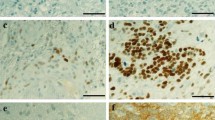Abstract
There is increasing recognition of familial propensity to glioma as a distinct clinical entity beyond a few rare syndromes; however its genetic basis is poorly understood. The role of p16 INK4A /p14 ARF and p53 mutations in sporadic glioma provides a strong rationale for investigating germline mutations in these genes as a cause of familial glioma. To survey the familial glioma phenotype and examine the contribution of germline mutation in p16 INK4A /p14 ARF and p53 to the disease we have analyzed a series of 101 index familial cases collected through the GLIOGENE Consortium (http://braintumor.epigenetic.org/). There was little evidence for within family correlations for tumour histology, suggesting generic susceptibility to glial tumors. We did not detect any functional mutations in p16 INK4A or p14 ARF. One index case with glioblastoma multiforme (GBM) diagnosed at age 54 and had a family history comprised of a paternal aunt with GBM at age 55, carried the p53 R158H mutation, which is predicted to be functional and has previously been implicated as a cause of Li-Fraumeni syndrome. Our findings provide no evidence that p16 INK4A /p14 ARF and p53 mutations contribute significantly to familial glioma.
Similar content being viewed by others
References
Bondy ML et al (2008) Brain tumor epidemiology: consensus from the brain tumor epidemiology consortium. Cancer 113(7):1953–1968
Hemminki K et al (2009) Familial risks in nervous-system tumours: a histology-specific analysis from Sweden and Norway. Lancet Oncol 10(5):481–488
Kyritsis AP et al (1994) Germline p53 gene mutations in subsets of glioma patients. J Natl Cancer Inst 86(5):344–349
Li YJ et al (1995) Incidence of germ-line p53 mutations in patients with gliomas. Int J Cancer 64(6):383–387
Tachibana I et al (2000) Investigation of germline PTEN, p53, p16(INK4A)/p14(ARF), and CDK4 alterations in familial glioma. Am J Med Genet 92(2):136–141
Gao L et al (1997) Lack of germ-line mutations of CDK4, p16(INK4A), and p15(INK4B) in families with glioma. Clin Cancer Res 3(6):977–981
Paunu N et al (2001) Analysis of p53 tumor suppressor gene in families with multiple glioma patients. J Neurooncol 55(3):159–165
Malmer B et al (2001) Microsatellite instability, PTEN and p53 germline mutations in glioma families. Acta Oncol 40(5):633–637
Malmer B et al (2007) GLIOGENE an international consortium to understand familial glioma. Cancer Epidemiol Biomarkers Prev 16(9):1730–1734
Yan H et al (2009) IDH1 and IDH2 mutations in gliomas. N Engl J Med 360(8):765–773
Varley JM et al (1999) Are there low-penetrance TP53 Alleles? Evidence from childhood adrenocortical tumors. Am J Hum Genet 65(4):995–1006
Randerson-Moor JA et al (2001) A germline deletion of p14(ARF) but not CDKN2A in a melanoma-neural system tumour syndrome family. Hum Mol Genet 10(1):55–62
Bahuau M et al (1998) Germ-line deletion involving the INK4 locus in familial proneness to melanoma and nervous system tumors. Cancer Res 58(11):2298–2303
Scheurer ME et al (2007) Aggregation of cancer in first-degree relatives of patients with glioma. Cancer Epidemiol Biomarkers Prev 16(11):2491–2495
Goldgar DE et al (1994) Systematic population-based assessment of cancer risk in first-degree relatives of cancer probands. J Natl Cancer Inst 86(21):1600–1608
Shete S et al (2009) Genome-wide association study identifies five susceptibility loci for glioma. Nat Genet 41(8):899–904
Wrensch M et al (2009) Variants in the CDKN2B and RTEL1 regions are associated with high-grade glioma susceptibility. Nat Genet 41(8):905–908
Acknowledgments
We are grateful to all patients, their clinicians and other individuals for their participation in this study. Work was undertaken with grant support from NIH R01 CA119215 01, American Brain Tumor Association, and National Brain Tumor Society and the Tug McGraw Foundation. Work in the Houlston laboratory is supported by Cancer Research UK (Bobby Moore C1298/A8362).
We acknowledge the following Gliogene Consortium members; Phyllis Adatto, Fabian Morice (MADCC); Lisa Calvocoressi, Kate Saunders (BW); Karen Devine, Gene Barnett, Cathy Brewer, Elizabeth Ennis (Case); Stacy Murray (Duke); Mitchel Berger, Susan Chang, Michael Prados, Terri Rice (UCSF); Christina Corpuz, Erika Florendo, Steven Rosenfeld (Columbia University); Candice Zahora (UIC); Jan C Buckner, Caterina Giannini, Brian P O’Neill, Deb Sprau (Mayo Clinic); Lisa M. DeAngelis, Erica Schubert, Sharon Bayuga (MSK); Pat Lada (NorthShore University HealthSystem); Deborah T. Blumenthal (Gertner Institute); Zvi Ram (Tel-Aviv University); Hans Bolander, Gudrun Byström, Roger Henriksson, Guiseppe Stragliotti and Fredrik Wiklund (Umeå University).
Author information
Authors and Affiliations
Corresponding author
Additional information
An erratum to this article can be found at http://dx.doi.org/10.1007/s10689-010-9353-6
Electronic supplementary material
Below is the link to the electronic supplementary material.
Rights and permissions
About this article
Cite this article
Robertson, L.B., Armstrong, G.N., Olver, B.D. et al. Survey of familial glioma and role of germline p16 INK4A /p14 ARF and p53 mutation. Familial Cancer 9, 413–421 (2010). https://doi.org/10.1007/s10689-010-9346-5
Published:
Issue Date:
DOI: https://doi.org/10.1007/s10689-010-9346-5




